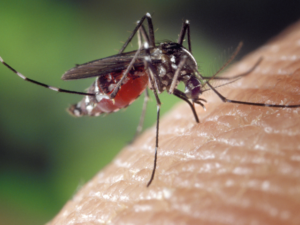 Corresponding Author: Michelle Evans, mvevans@uga.edu
Corresponding Author: Michelle Evans, mvevans@uga.edu
Summary Author: Leah Crone, lec62627@uga.edu
Mosquitoes are largely affected by the environment in which they live as larva. The surroundings that a larva experiences may influence characteristics in the adult mosquito, a phenomenon known as a carry-over effect. While studies have shown that the larval environment can affect disease transmission potential for individual mosquitoes, the net impact of carry-over effects on overall transmission potential is unclear. In recently published work, CEID members Michelle Evans, Nicole Solano, John Drake, Courtney Murdock and their collaborators examined the effect different environments, temperatures, and seasons had on the dengue-2 virus transmission potential in Aedes albopictus mosquitoes. They also sought to examine how the failure to account for carry-over effects may influence estimates of vectoral capacity, which is the rate at which future infections arise from one infectious mosquito. The team distributed 3600 larvae in both the summer and autumn to a variety of sites classified as either rural, suburban, or urban environments, and collected the adult mosquitoes as they emerged. They then recorded observations found in each environment and in traits exhibited by the adult mosquitoes. Using these observations and the existing literature, they calculated the vectoral capacity for each site and season. Analysis found that differences in the larval environment can shape Aedes albopictus population dynamics and dengue-2 transmission potential through carry-over effects on vector competence (the ability to acquire, maintain, and transmit the virus) and fecundity (ability to reproduce). They also found that calculations of vectoral capacity that do not address these carry-over effects may result in underestimates in suburban and urban sites in the summer and overestimates in the autumn when compared to calculations of vectoral capacity that do address carry-over effects. This work calls for a better understanding of how carry-over effects influence disease transmission, and demonstrates how this understanding may improve future models and fine-scale predictions of disease incidence.
Evans, Michelle, et al. “Carry-over effects of urban larval environments on the transmission potential of dengue-2 virus” Parasites & Vectors, (2018), 11:426 https://doi.org/10.1186/s13071-018-3013-3
Photo Credit: James Gathany, Centers for Disease Control and Prevention